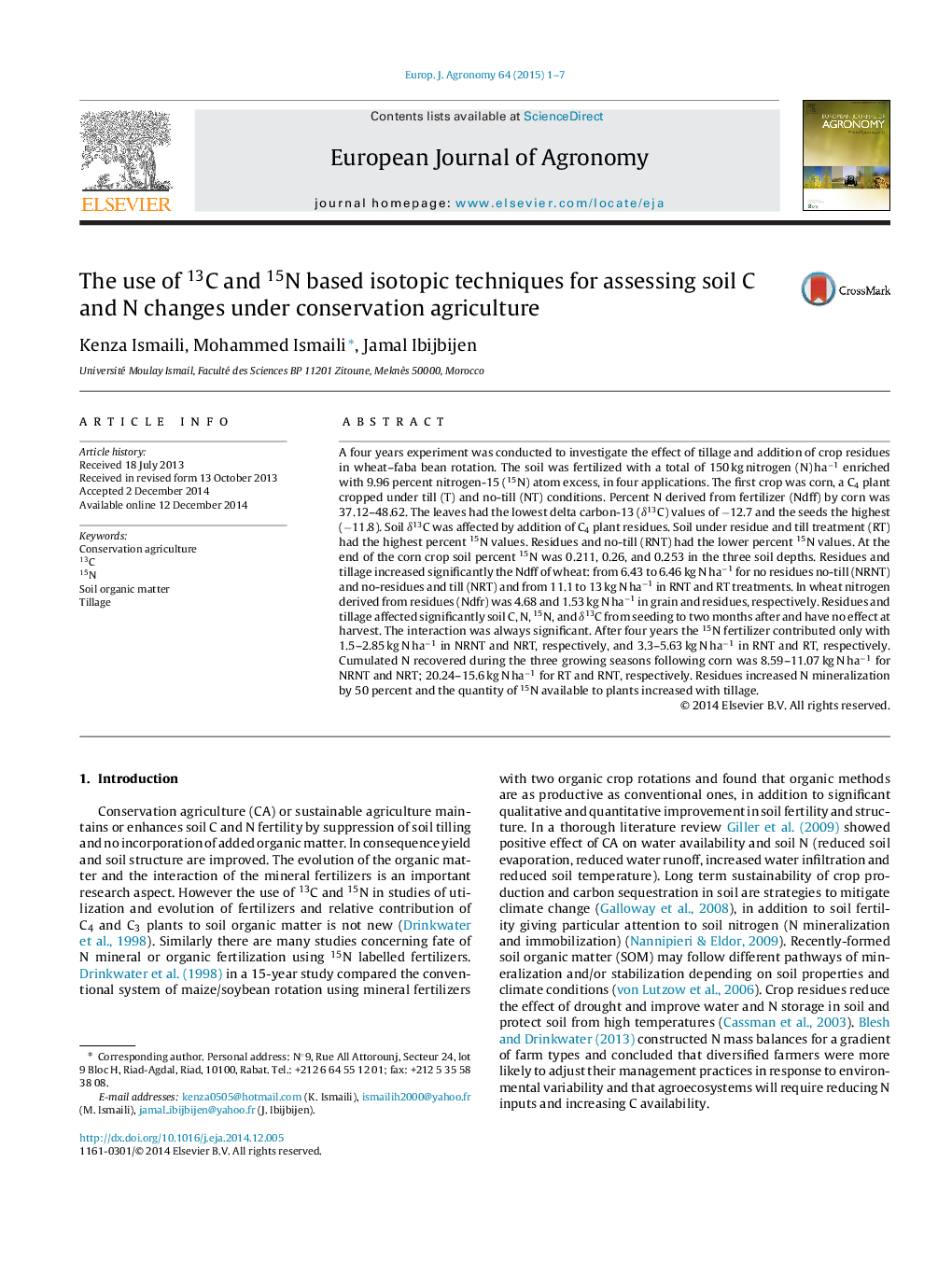| کد مقاله | کد نشریه | سال انتشار | مقاله انگلیسی | نسخه تمام متن |
|---|---|---|---|---|
| 4508829 | 1624461 | 2015 | 7 صفحه PDF | دانلود رایگان |

• A long term field experiment was conducted to investigate the effect of tillage and addition of crop residue in wheat–faba bean–wheat rotation. The soil was fertilized with a total of 150 kg nitrogen (N) ha−1 enriched with 9.96 percent nitrogen-15 (15N) atom excess, in four applications. The objectives of this study were to: (i) follow the changes in SOC in Mediterranean climate after adding C4 plant residues (corn) enriched with 15N under tilled and not-till treatments, (ii) evaluate the beneficial effects of CA system (no-till and residues left on the surface of soil) on soil N and C sequestration, and (iii) estimate the extent of biodegradation of corn crop residues through time and the effect of corn residues on the δ13C values of soil.
• A field experiment was conducted to investigate CA system based on wheat (Triticum durum Oum Rbia G3 2004)–faba bean (Vicia faba L.) with an average rainfall of 500 mm year. The soil was sandy loam well drained, of poor fertility and low water holding capacity. Four replicates were used. The first crop was corn (Zea mays var. rugosa), a C4 plant seeded on 16 plots (16 m2) fertilized with 150 kg N ha−1 in four applications: 25 kg N ha−1 at seeding, 25 kg N ha−1 two weeks after seeding, 50 kg N ha−1 one month after seeding and 50 kg N ha−1 two months after seeding. Nitrogen was added as ammonium sulphate enriched with 9.96 percent atom 15N excess at all applications.
• We concluded that the use of 13C and 15N as tracers of C and N in conservation agriculture experiments showed that leaving the crop residues on the soil and no tillage improved soil organic carbon and nitrogen nutrition of the crops and the major factors affecting yield and soil organic matter. The use of C4 plant crop residues as tracer of carbon in the soil is a good technique when used with 15N to evaluate N nutrition of crops and soil organic carbon stock. Addition of C4 residues to soil as one application in one season did affect the δ13C values in soil.
• The residue and tillage treatments had the highest percent 15N values and increased mineralized N by 50%. When the residues were left on the soil the wheat plants cumulated more nitrogen. Most of the fertilizer N was recovered by the first crop, the following crops recovered less N. Nitrogen recovery increased with residue addition and tillage. Nitrogen not recovered by the crops was low in residue treatment and high in no residue treatments. Most of the N not recovered is in the soil organic matter.
• Soil water was higher in the no-till and residues treatments. Water use efficiency was improved by no-till treatment and addition of residues showing that in Mediterranean climate conservation agriculture would give rapid and better results. Maintaining organic matter levels in the soil will therefore remain a crucial component of sustainable agricultural practices. The 13C discrimination together with 15N was shown to be the tool to be used for the assessment of water, nitrogen and carbon in the soil plant system.
A four years experiment was conducted to investigate the effect of tillage and addition of crop residues in wheat–faba bean rotation. The soil was fertilized with a total of 150 kg nitrogen (N) ha−1 enriched with 9.96 percent nitrogen-15 (15N) atom excess, in four applications. The first crop was corn, a C4 plant cropped under till (T) and no-till (NT) conditions. Percent N derived from fertilizer (Ndff) by corn was 37.12–48.62. The leaves had the lowest delta carbon-13 (δ13C) values of −12.7 and the seeds the highest (−11.8). Soil δ13C was affected by addition of C4 plant residues. Soil under residue and till treatment (RT) had the highest percent 15N values. Residues and no-till (RNT) had the lower percent 15N values. At the end of the corn crop soil percent 15N was 0.211, 0.26, and 0.253 in the three soil depths. Residues and tillage increased significantly the Ndff of wheat: from 6.43 to 6.46 kg N ha−1 for no residues no-till (NRNT) and no-residues and till (NRT) and from 11.1 to 13 kg N ha−1 in RNT and RT treatments. In wheat nitrogen derived from residues (Ndfr) was 4.68 and 1.53 kg N ha−1 in grain and residues, respectively. Residues and tillage affected significantly soil C, N, 15N, and δ13C from seeding to two months after and have no effect at harvest. The interaction was always significant. After four years the 15N fertilizer contributed only with 1.5–2.85 kg N ha−1 in NRNT and NRT, respectively, and 3.3–5.63 kg N ha−1 in RNT and RT, respectively. Cumulated N recovered during the three growing seasons following corn was 8.59–11.07 kg N ha−1 for NRNT and NRT; 20.24–15.6 kg N ha−1 for RT and RNT, respectively. Residues increased N mineralization by 50 percent and the quantity of 15N available to plants increased with tillage.
Journal: European Journal of Agronomy - Volume 64, March 2015, Pages 1–7